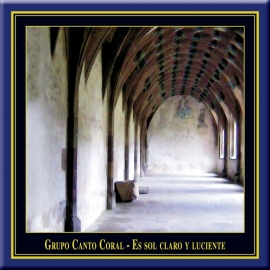Grupo de Canto Coral

Chamber Choir and Baroque Orchestra
Dir.: Néstor Andrenacci
Except for specialists, very little is known about the musical aspects of colonial Latin America. Following the arrival of conquerors and colonizers, an extremely important cultural symbiosis slowly begins to take shape. This process extends all the way to the end of the 18th century and, in some regions, it lasts up to the early 19th century along with the wars of independence.
This period witness the development of a large and rich heritage in architecture, painting, sculpture, and literature. The Cuzco paintings or the works of Aleijadinho in Brazil, suffice to recognize important peculitarities. A similar process takes place with the music. Just as the University of Salamanca was the model for New World institutions of higher learning, the Music Chapel of Seville Cathedral became the paradigm for those to be established in the key cities of viceroyalities overseas. They received important musicians, printed music or manuscript copies, instruments and theoretical writings. Nearly the entire corpus of this music can be found in ecclesiastical repositories and are associated with the church and its celebrations. However, few examples of profane works remain.
Several researchers have devoted themselves to explore these centuries. At the same time they have started a search for documents of the period: data written down by priests in church-books, listings of church expenditures which includes singers and interpreters, instruments acquired an celebrations in which they took part. Their study and analysis, as well as the chronicles of priests and travellers, teach us about the norms that ruled music in American Chapels, their composers and the bulk of their repertoire. In Mexico. Lima, Sucre or Cuzco, the Chapel Master guided his „schola“, controlling its daily practices while, at the same time, composing new works for successive festivities. We should recall that most choral singers, singing and dancing choir boys and interpreters as well as composers were indigenous, and in Brazil, mulattos.
The repertoire included a variety of sources: books printed in and regularly received from Europe, the works of resident maestros, often of great value, and later on, works of native composers formed in Latin America. We can identify three key musical periods. The first period in Mexico, with „a capella“ polyphony which recalls Spanish Renaissance. there we can find Liturgical works and Christmas carols, as well as toys, melodies and pitaresque ballads.
The Grupo Canto Choral, which consists on a Chamber-choir and a baroque-orchestra, applies to the best choirs of Argentina. It is founded in 1973 by its current conductor Néstor E. Adrenacci. Many tours carried this ensemble to Europe and the United States. For example in 1993 the CCG was invited by the the International Federation for Choral Music (IFCM) to represent South America at the 3th world symposium for choral music in Vancouver / Canada.





